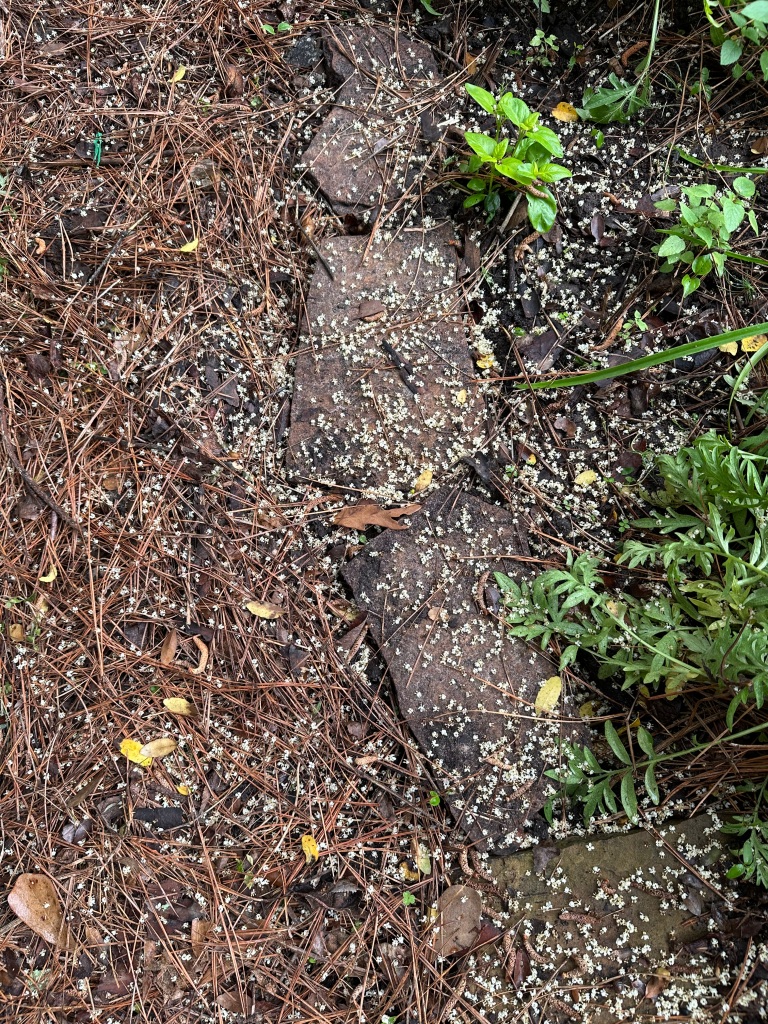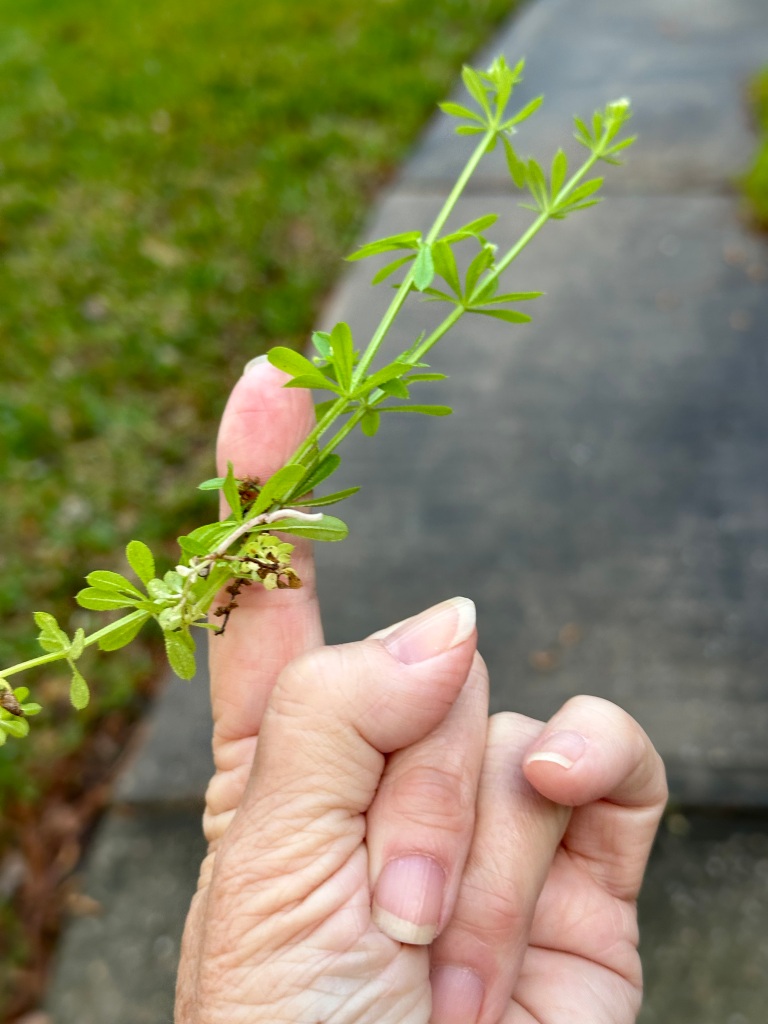Texas Spring
Posted: March 25, 2024 Filed under: Gardening | Tags: Blue Bonnets, Gulf Coast gardening, hardy, Ilex vomitoria, Southern Gardening, Yaupon Holly, Year-round gardening 25 Comments
In Texas, the first sign of spring is the annual blooming of Blue Bonnets. I try to have a few in the garden every year.

The native Yaupon Holly trees’ tiny flowers have opened with a scent that fills the air. Their botanical name Ilex vomitoria comes with a warning.

The diminutive flowers cover the ground like snow.

And with spring comes weeds. This is a sticky weed. As I have mentioned before, I don’t take up brain space learning weeds’ proper names. I wish I had counted the bushels of weeds I pulled this spring.
Christmas Miracles in the Garden
Posted: December 23, 2020 Filed under: Uncategorized | Tags: Aechhmea recurvata, American Robin, Automatic Gardening, bougainvillea, Southern Gardening, Subtropical Gardening, Yaupon Holly 19 Comments
There has been a few small miracles in the garden. Nature somehow knew this was the year that something was needed to lift spirits. The bougainvillea has bloomed for the first time since it was brought home from the nursery many years ago. The plant didn’t put on much of a show, but it was enough to brighten the season with its reddish flowers.

This plant, which I believe is a Aechmea recurvata Bronze Age and if anyone can identify it please do, has taken a lot of abuse over the years. Rabbits have eaten it back and it had to endure flooding rains. But, this year the plant has finally decided to make some flowers.

The flowers are slow growing and I will update its progress.
Another small miracle, which is personal for me, was a flock of Robins that landed in the yard. The birds busily finished off the berries on the Yaupon Holly and headed to the lawn to look for bugs. Robins always remind me of my childhood up North. In the early evening when we were playing outside, the Robins were always hopping nearby looking for their last meal of the day.
I hope in this difficult year, you all have found a small miracle here and there to bring a bit of joy.
Cedar Waxwings Feeding Frenzy
Posted: March 3, 2019 Filed under: Gardening | Tags: American Robin, Backyard Critters, Cedar Waxwings, Gulf Coast gardening, nature photography, subtropical climate, Yaupon Holly 17 CommentsWe recently spent an afternoon watching Cedar Waxwings descend upon a holly bush loaded with red berries.
The Cedar Waxwings are beautiful birds with their black masks and pale yellow belly. This photo caught the red tips on this one’s wing. The birds have a bright yellow tip on their tails.
There were probably more than 50 individuals in this flock. They arrived in waves, occasionally taking breaks. The Waxwings had already stripped a nearby holly. Earlier in the winter they ate all the berries from the native Yaupon Holly trees in the yard.
They were so eager to feed that they flew closely over our heads and under the front porch. A few hit the windows, but survived.
Across the street a large flock of American Robins had been gathering and one finally came over to check out the action.
Cedar Waxwings
Posted: January 18, 2017 Filed under: Gardening | Tags: American Holly Tree, Automatic Gardening, Backyard Critters, Cedar Waxwings, Gulf Coast gardening, Holly Berries, nature photography, subtropical climate, Yaupon Holly 6 CommentsTiming is everything. As I was preparing my posts on Holly Trees, the Cedar Waxwings arrived to feast on the berries. I was alerted of the birds presence by my resident birds. The Cardinals, Titmice, Chickadees and Carolina Wrens gathered to check out the visitors. (click to enlarge)
Luckily, the birds stayed long enough that I could get the camera and switch lenses. Waxwings fly off at the slightest disturbance. The photos are highly cropped as it was hard to get very close.
I was very pleased to get an almost perfect shot of this beautiful Cedar Waxwing.
Ilex vomitoria
Posted: January 17, 2017 Filed under: Gardening | Tags: Automatic Gardening, Backyard Critters, Cardinals, Cedar Waxwings, Gardening, Gulf Coast gardening, Ilex vomitoria, Piney Forest, Yaupon Holly, Year-round gardening 15 CommentsNotice the second part of this tree’s botanical name. What does that word bring to mind? Yes, the name comes with a big warning. If you eat the berries, the result is not pretty.
We know this tree as Yaupon Holly and is another native of the Piney Forest. Yaupons usually have skinny trunks and grow just about anywhere, as between these two pines. Like the American Tree Holly in the previous post, it makes tiny flowers in the spring with the berries forming quickly. It is a small tree and will spread by root. Most consider it a weed tree.
But it has many hidden secrets, besides what happens when humans eat the berries. Its flowers are a food source for bees. Cardinals dine on the berries and flocks of Cedar Waxwings devour them. Now for humans, we can make tea from the leaves which contain caffeine and antioxidants (make sure you do research before eating it). With a name like vomitoria, I think I will skip the tea!
The End and the Beginning
Posted: January 20, 2013 Filed under: Uncategorized | Tags: Chinese Tallow Tree, Gulf Coast gardening, Sweet Gum Tree, Yaupon Holly Leave a commentSweet Gum Tree
Yaupon Holly
Chinese Tallow
****************************************
The end of one season is the beginning of the next. The leaves are gone, but the trees will decorate themselves with their hope for next season. The seeds attract birds and squirrels that eat their fill and assist to disperse the rest. As many plants rest, beauty can still be found in their end efforts.













